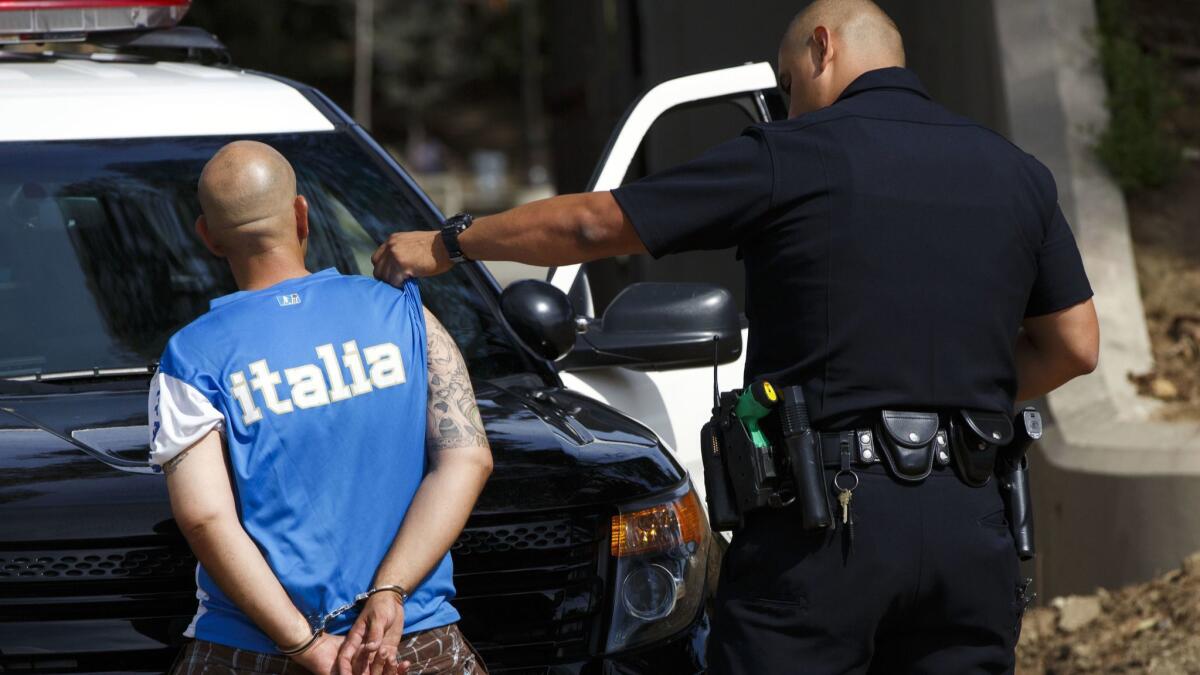Editorial: Keep gang injunctions in L.A.’s crime-fighting toolbox

- Share via
Just as Los Angeles officials were finally acknowledging, and correcting, their blunt misuse of gang injunctions, a federal court said in essence that the fixes were “too little, too late.” Chief U.S. District Judge Virginia A. Phillips last week enjoined the city from enforcing its injunctions — court orders that restrict the activity of particular people in designated neighborhoods in the name of curbing gang violence.
Now L.A. lawyers and police have to decide whether to give up on injunctions entirely. Gangs are a more manageable challenge than they were in the violent 1980s and 1990s, and police and city officials have found less-intrusive tools to fight gang violence. Besides, the city badly overstepped constitutional bounds in the past by barring alleged gang members, many of whom had been neither charged with crimes nor convicted, from gathering together, wearing particular clothing or engaging in otherwise perfectly legal activity — without giving them a chance to defend their liberties in court. That practice left the whole system tainted.
But it’s not too late.
The court did not bar gang injunctions, which can be crafted with sufficient care and creativity to respect the constitutional rights of innocent people while still protecting communities from thuggish gang behavior. The task is to see the injunctions as the useful tools they can be, and not as what they too often became — a policing shortcut and a weapon of oppression against individuals that restricted their behavior based not on what they did but on who they were.
Gang injunctions were pioneered by Los Angeles County officials but mushroomed under their L.A. city counterparts in the 1980s and 1990s during a historic increase in deadly youth violence.
There is no reason for the city not to keep its crime-fighting tools well honed and up to date.
The theory was based on the well-established “law of nuisance.” Individuals or groups whose actions interfere with the ability of others to reasonably carry out their daily lives in health and safety can be blocked in a lawsuit, as opposed to a criminal case. Those who are subject to the complaint have to modify their activity or else be penalized.
But injunctions too often allowed police on the street to determine who was a gang member and thus who was subject to the court order. A person who had never joined a gang could too easily discover that he had been added to an injunction, and that he would be subject to criminal sanctions for activity such as wearing a Dodgers jacket or chatting on the front steps with a cousin.
Opponents argued that in addition to injunctions being unconstitutional, they were ineffective. But effectiveness is subject to some serious dispute. The grip of gangs in some neighborhoods was loosened. It became more difficult for gangs to target large gatherings of rivals.
By 2013, Los Angeles had 45 gang injunctions, naming hundreds of people, and was about to add one more — in Echo Park. Community debates were fierce, with opponents arguing that gang injunctions were a tool not to fight crime but to further gentrification by harassing longtime residents and pressuring them to leave their homes, to be replaced by wealthier and generally whiter newcomers. Other longtime residents pushed back, arguing that they had long been intimidated from speaking out by their more aggressive, gang-affiliated neighbors.
The Echo Park injunction was added, but in the meantime new City Attorney Mike Feuer took office and brokered an agreement to allow people named in injunctions to be removed if they could show they did not deserve to be on the list. It was a step in the right direction but still was too timid and allowed the worst excesses of gang injunctions to continue operating.
Last year, Feuer went further and agreed to drop enforcement against more than three-quarters of the people covered by city injunctions. Finally, the city had moved close to a proper balance — but it remained the case that some alleged gang members had their activity restricted based on court orders that had taken effect before they had a meaningful chance to challenge them. Judge Phillips’ ruling last week means in essence that the city has to start over — or forget gang injunctions altogether.
A constitutional gang injunction would provide adequate prior notice to its target and would establish in court, beyond a reasonable doubt, that the person is involved in gang activity. It would be time-limited and would provide adequate opportunity for the subject to seek removal, by following criteria approved in court.
Ending injunctions would send the pendulum swinging too far in the other direction. There is no reason for the city not to keep its crime-fighting tools well honed and up to date. Nor is there any reason to believe that they cannot craft those tools carefully, so that they comply with the Constitution and respect the dignity and the civil rights of the people to be covered.
Follow the Opinion section on Twitter @latimesopinion and Facebook
More to Read
A cure for the common opinion
Get thought-provoking perspectives with our weekly newsletter.
You may occasionally receive promotional content from the Los Angeles Times.









